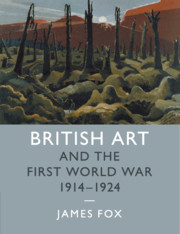Book contents
- Frontmatter
- Contents
- List of plates
- List of figures
- Acknowledgements
- Introduction
- 1 The outbreak of war and the business of art
- 2 Perceptions of art
- 3 The arts mobilize
- 4 War pictures: truth, fiction, function
- 5 Peace pictures: escapism, consolation, catharsis
- 6 Art and society after the war
- Conclusion
- Notes
- Bibliography
- Index
- Index
1 - The outbreak of war and the business of art
Published online by Cambridge University Press: 05 August 2015
- Frontmatter
- Contents
- List of plates
- List of figures
- Acknowledgements
- Introduction
- 1 The outbreak of war and the business of art
- 2 Perceptions of art
- 3 The arts mobilize
- 4 War pictures: truth, fiction, function
- 5 Peace pictures: escapism, consolation, catharsis
- 6 Art and society after the war
- Conclusion
- Notes
- Bibliography
- Index
- Index
Summary
At the beginning of August 1914 politicians and businessmen alike were optimistic about the opportunities that war would bring. Both believed that unabated commercial activity would help Britain defeat Germany by capturing her trade. A policy of ‘business as usual’ – which in the early months of the war was endlessly extolled in newspapers, trades journals and government speeches – thus seemed to represent a felicitous combination of profit and patriotism, in which both business and the business of war would become mutually reinforcing aspects of national success. As the weeks progressed, however, these predictions were proved emphatically incorrect. Precisely as the virtues of ‘business as usual’ were being praised, the nation's conventional business patterns were falling apart. Amid the uncertain political landscape Britain's banks ceased to lend money, its traders ceased to speculate and its public – gripped as they were by the unfolding events of the conflict – changed their consumption habits altogether. These developments had severe consequences for the country's businesses: indeed, by September nine out of ten firms had suffered as a result of the conflict.
British art was not insulated from the financial dislocation that affected the country's other businesses. It was, after all, a business as well, and like others it thrived only in favourable economic conditions. Art historians have traditionally neglected these commercial imperatives of art. Those who have studied the war have generally focused on individual experiences, intellectual epiphanies and stylistic reorientations. Yet by ignoring the institutions that surrounded those individuals, the markets that mediated their work and the social conditions that gave rise to their creations, they have often failed to explore what were surely the conflict's most striking artistic consequences. The outbreak of war had a catastrophic impact on the established institutions and practices of art: it affected buyers, auction houses, dealers, museums, exhibiting societies and arts charities just as much as it affected artists; and its material effects were, if anything, more damaging than the aesthetic consequences that have hitherto received more attention.
This chapter will use Howard Becker's concept of an ‘art world’ – a ‘social system’ that involves collaboration between artists, businesses, organizations and audiences – to reach a wider, and more social, understanding of British art after 1914.
- Type
- Chapter
- Information
- British Art and the First World War, 1914–1924 , pp. 11 - 31Publisher: Cambridge University PressPrint publication year: 2015



